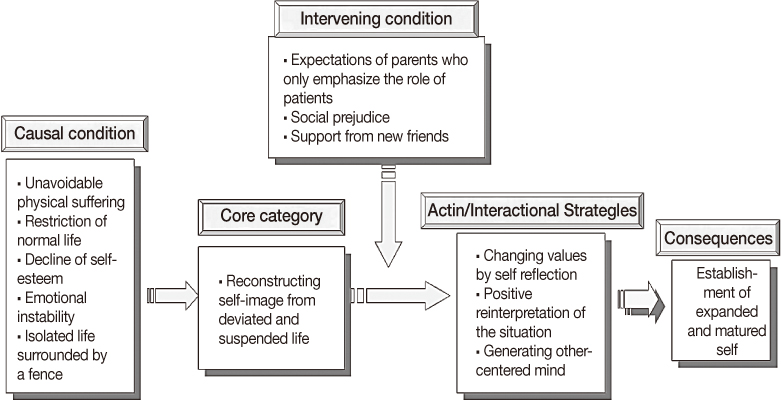J Korean Acad Nurs.
2011 Oct;41(5):603-612. 10.4040/jkan.2011.41.5.603.
Illness Experience of Adolescents with Hematologic Malignancies
- Affiliations
-
- 1Yonsei University College of Medicine, Gangnam Severance Hospital, Seoul, Korea. Childnurse@hanmail.net
- KMID: 1031099
- DOI: http://doi.org/10.4040/jkan.2011.41.5.603
Abstract
- PURPOSE
The purpose of this study was to describe the experience process of adolescents with hematologic malignancies. The question for the study was "What is the experience of adolescents with hematologic malignancies like?".
METHODS
The grounded theory methodology was used for this study. The data were collected through in-depth interview from 10 adolescents with hematologic malignancies. Data collection was done from January to June 2007. Theoretical sampling was used until the data reached saturation.
RESULTS
As a result of the analysis, "Reconstructing self-image from deviated and suspended life" was identified as the core category. And 11 subcategories were identified and they were integrated to the core category. 'Establishment of expanded and matured self' was identified as the consequence.
CONCLUSION
The results of the study provide a frame for effective individualized nursing intervention strategies in helping adjustment of the adolescents with hematologic malignancies.
MeSH Terms
Figure
Cited by 1 articles
-
The Illness Adaptation Process of Patients Suffering from Myelodysplastic Syndrome (MDS): Doing My Best in Uncertainty
Ae-Kyung Kim
Korean J Adult Nurs. 2017;29(5):472-483. doi: 10.7475/kjan.2017.29.5.472.
Reference
-
1. Anholt U, Fritz G, Keener M. Self-concept in survivors of childhood and adolescent cancer. Journal of Psychosocial Oncology. 1993. 11:1–6. doi: 10.1300/J077V11N01_01.2. Cassano J, Nagel K, O'Mara L. Talking with others who "Just know": Perceptions of adolescents with cancer who participate in a teen group. Journal of Pediatric Oncology Nursing. 2008. 25:193–199. doi: 10.1177/1043454208319972.3. Chang HS. Attachments to parents, separation-individuation and psychological adjustment in late adolescence. Korean Journal of Developmental Psychology. 2002. 15:101–121.4. Choi JY. Development of a treatment stage based nursing intervention protocol for adolescents with cancer. 2000. Seoul: Yonsei University;Unpublished doctoral dissertation.5. Enskar K, Carlsson M, Golsater M, Hamrin E, Kreuger A. Parental reports of changes and challenges that result from parenting a child with cancer. Journal of Pediatric Oncology Nursing. 1997. 14:156–163. doi: 10.1016/S1043-4542(97)90051-5.6. Forinder U, Posse E. A life on hold: Adolescents' experiences of stem cell transplantation in a long-term perspective. Journal of Child Health Care. 2009. 12:301–313. doi: 10.1177/1367493508096205.7. Griffith K, Hart L. Characteristics of adolescent cancer survivors who pursue postsecondary education. Cancer Nursing. 2000. 23:468–475.8. Hokkanen H, Eriksson E, Ahonen O, Salantera S. Adolescents with cancer: Experience of life and how it could be made easier. Cancer Nursing. 2004. 27:325–335.9. Im SB, Jung CS. A comparison of stressors and coping behaviors of the high school students who have suicidal ideation vs those who do not. Journal of Korean Academy of Nursing. 2002. 32:254–264.10. Ishibashi A. The need of children and adolescents with cancer for information and social support. Cancer Nursing. 2001. 24:61–67.11. Kane J, Primomo M. Alleviating the suffering of seriously ill children. American Journal of Hospice Palliative Care. 2001. 18:161–169. doi: 10.1177/104990910101800307.12. Kang KA. The experience of adolescents with cancer. Korean Journal of Nursing Query. 1997. 6(2):67–87.13. Kim HR. The experience of adolescents with childhood cancer in a self-help group program. 2006. Seoul: Yonsei University;Unpublished masters' thesis.14. Kim HO, Lee JS. Emotional autonomy in Korean and German adolescents. The Korean Journal of Development Psychology. 2006. 19:21–40.15. Lincoln YS, Guba EG. Naturalistic inquiry. 1985. Newbury Park, CA: Sage Publications.16. Linder LA. Measuring physical symptoms in children and adolescents with cancer. Cancer Nursing. 2005. 28:16–26.17. Meltzer LJ, Rourke MT. Oncology summer camp: Benefits of social comparison. Children's Health Care. 2005. 34:305–314. doi: 10.1207/s15326888chc3404_5.18. Ryu EJ, Choi KS, Seo JS, Nam BW. The relationships of internet addiction, depression, and suicidal ideation in adolescents. Journal of Korean Academy of Nursing. 2004. 34:102–110.19. Ryu MA. Content analysis on psychosocial adjustment of adolescent survivors of leukemia. Journal of Korean Academy of Child Health Nursing. 2006. 12:304–313.20. Strauss A, Corbin J. Basics of qualitative research: Techniques and procedures for developing grounded theory. 1998. 2nd ed. Thousand Oaks, CA: Sage Publications.21. Ward-Smith P, McCaskie B, Rhoton S. Adolescent evaluated quality of life: A longitudinal study. Journal of Pediatric Oncology Nursing. 2007. 24:329–333. doi: 10.1177/1043454207308067.22. Whyte F, Smith L. A literature review of adolescence and cancer. European Journal of Cancer Care. 1997. 6:137–146. doi: 10.1046/j.1365-2354.1997.00022.x.23. Woodgate R, Degner L. A substantive theory of keeping the spirit alive: The spirit within children with cancer and their families. Journal of Pediatric Oncology Nursing. 2003. 20:103–119. doi: 10.1053/jpon.2003.75.24. Woodgate RL. A different way of being: Adolescents' Experiences with cancer. Cancer Nursing. 2005. 28:8–15.25. Woodgate RL. The importance of being there: Perspective of social support by adolescents with cancer. Journal of Pediatric Oncology Nursing. 2006a. 23:122–134. doi: 10.1177/1043454206287396.26. Woodgate RL. Life is never the same: Childhood cancer narratives. European Journal of Cancer Care. 2006b. 15:8–18. doi: 10.1111/j.1365-2354.2005.00614.x.27. Woodgate RL. Feeling state. Cancer Nursing. 2008. 31:229–238.
- Full Text Links
- Actions
-
Cited
- CITED
-
- Close
- Share
- Similar articles
-
- Psychosocial Adjustment of Adolescents with Hematologic Malignancies: Self-integration from Deviated Life
- Extracorporeal Life Support in Patients with Hematologic Malignancies: A Single Center Experience
- Incidence and Types of Constitutional Chromosomal Abnormalities in Patients with Hematologic Malignancies
- Risk of Hematologic Malignancies in Patients with Inflammatory Bowel Disease: A Meta-Analysis of Cohort Studies
- Immune Response to COVID-19 Vaccination in Hematologic Malignancies: A Mini-Review


